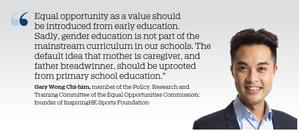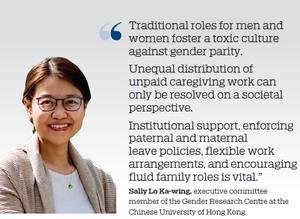McKinsey estimates a global boost of $13 trillion by 2030 if nations implement gender parity now. Traditional gender role models limit women’s value to family and society. Women are less likely than men to take STEM education, which keeps them away from high-paying jobs. Experts argue for more women in policymaking, and less gender bias at work. Wang Yuke reports.
This year marks the 25th anniversary of the Fourth World Conference on Women in Beijing, and 100 years since women won the right to vote in the United States. 2020 is also particularly significant for the global COVID-19 pandemic, which disproportionately affects women in the front-line medical, hospitality, education, and caregiver professions.
The social-distancing order has closed kindergartens, schools, and nurseries, obliging parents to keep children at home. Parents need to manage online learning, in addition to routine domestic chores. That burden has fallen mainly on working mothers, forcing many to give up fulltime jobs.
The McKinsey Global Institute study, COVID-19 and Gender Equality: Countering the regressive effects, reported: “We estimate that 4.5 percent of women’s employment is at risk in the pandemic globally, compared with 3.8 percent of men’s employment, just given the industries that men and women participate in.” Women, estimated by McKinsey, are 19 percent more exposed to risk through sectors they serve — in accommodation, catering, retail and wholesale trade, education, etc.
The McKinsey study estimated that taking action now to correct gender inequality could potentially add $13 trillion to global GDP by 2030. If no action is taken, global GDP growth could be $1 trillion lower in 2030.
Power imbalance
The United Nations Foundation estimated another century for global gender parity. Until public policy drives it, which the prevailing political power imbalance inhibits, women will remain disadvantaged at all levels.
Many UN member countries have adopted quota systems in parliamentary elections, like Belgium, Slovenia, France, Germany, Norway and Sweden. Setting electoral gender quotas is a positive step to increase female representation in political leadership.
The first Gender Social Norms Index released by the UN Development Programme this year noted that only 24 percent of parliamentary seats worldwide are held by women and there are only 10 female heads of government out of 193 member states.
LegCo record
The number of elected female candidates in Hong Kong Legislative Council has hovered between 16-18 percent of the total seats since 1998, according to the government’s report on women’s participation in public affairs. In 2019, just 19.5 percent of elected members in the district councils were female.
For the chairmanship and deputy chairmanship of panels, committees, and subcommittees of the fifth LegCo (2012-16), there were only 23 women, compared to 136 male officeholders.
Becoming a district councilor in Hong Kong involves joining a political party, finding a constituency, doing grassroots services, and gaining a public profile, before competing for election. That is hard for a woman to manage, says Gary Wong Chi-him, member of the Policy, Research and Training Committee of the Equal Opportunities Commission.
“Our election system is relatively young (from 1985) and therefore not yet fully female-friendly. We need female perspectives in policymaking, to guarantee girls’ and women’s welfare,” Wong says.
The Public Attitudes towards Female Political Leadership study, conducted jointly by the Equal Opportunities Commission and the Gender Research Centre at the Chinese University of Hong Kong, found that respondents expressed more confidence in men’s abilities on political reforms and labor issues. Song Jing, assistant professor of the Gender Studies Programme a,t the CUHK, who participated in the study, noted that “men often found themselves praised for devoting themselves to work. Women worry about being blamed for ignoring family.”

Pay gap
From data for 73 countries and regions covering about 80 percent of the world’s employees, the global gender pay gap stood at 16-22 percent, according to the Global Wage Report 2018-19.
In Hong Kong, for the 2017-18 academic year, 53,455 female students were admitted by the University Grants Committee-funded universities, compared to 46,752 males. But that is not reflected in employment statistics.
About 41.5 percent of adult women with a university degree were unemployed or outside the labor force, compared to only 17.2 percent of men, according to the International Labor Organization’s 2019 report.
The ILO World Employment Social Outlook 2017 reported that worldwide, the female participation rate in the labor market stood nearly 27 percentage points below men.
Caregiving not counted
According to the ILO, Women at Work: Trends 2016, women are more likely to withdraw from the job market because of the unpaid caregiving burden. The recent data shows globally, women are responsible for 76.2 percent of all unpaid care and domestic work, and perform more than three times as much of this work as men.
A stable family base is fundamental to a society’s well-being and prosperity. But this contribution, predominately undertaken by women, is left out of the System of National Accounts. The ILO study estimated the unpaid work at $10 trillion a year, representing 15 to over 50 percent of global GDP.
Song, referencing her study of self-employed women on the Chinese mainland, noted “Sacrifices by women for family solidarity and well-being require them to prioritize family over self-realization. Meanwhile, some women also believe that motherhood, as a source of life satisfaction, does not contradict career pursuits, even if they have to work intermittently.”
Pun Ngai, professor of sociology at the University of Hong Kong says “the social norm assigns women double roles. Working women assume responsibilities for children, the elderly, and household chores. The additional role thrust on women bothers employers, who prefer full commitment from employees.”
“Building more nurseries, kindergartens, elderly homes and care service facilities in communities will unburden working women considerably,” says Pun. She redresses the old-fashioned idea that women should devote more time to domestic work than men.
‘Social reproduction’
Pun’s economic analysis of “social reproduction” covers bearing and raising children, caring for working spouse, and tending to the sick, disabled, and bed-ridden family members. She argues for equal sharing, without gender bias. Pun finds other types of bias in male-dominated professions.
In the legal profession, about 30 percent of the city’s 1,597 barristers and 13 percent of its 104 senior counsel are women, according to Hong Kong’s Bar List. It is an inexplicable phenomenon, says Pun, that if a woman aspires to work in the legal trade, she will likely stay an “ordinary” lawyer throughout her career.
As male dominance persists, it solidifies a norm that the legal trade is a male preserve. “It creates a male culture,” Pun explains. “Women are considered less rational, because women are believed to be emotional and sentimental, which casts their judgment into doubt.”
Hurdles to promotion
Gender disparity awareness has been raised by the UN’s sustainable development goals, which place a high premium on gender equality.
“However, the number of female directors at listed companies in our city is below 30 percent,” says Wong. About 38 percent of listed companies had one female executive director last year, while only one company on the Hang Seng Index had a female CEO, according to a report by Community Business. Out of 611 listed company directorships, only 85 were held by women.
Females are readily admitted to entry-level jobs, but face hurdles as they advance to senior positions, notes Wong. Employers’ lack of confidence in women’s leadership capacity is one part of the story. The bigger part is the struggle for women to balance multiple roles in family and the workplace.
Gender issues always appear with other problems such as ethnicity or race discrimination and socioeconomic status, notes Sally Lo Ka-wing, a registered social worker and executive committee member of the Gender Research Centre at the CUHK. “This is termed ‘intersectionality.’ A simple example is that while women are facing inequality, black women will face more difficulties than white women,” Lo explains.
Above all, unpaid care provision should be redistributed equally between men and women. Care, more than a family or personal issue, is a collective challenge for society and policymakers to resolve, says Lo.

Digital skills
Gender imbalance is stark in the science, technology, engineering, and math sectors, dominated by men. A joint study by the ILO and LinkedIn shows that women are less likely to have digital skills, shutting them out of the highest paying jobs in the digital economy.
Statistics vary by country, but generally women make up only 15-25 percent of the current STEM workforce in the world, according to the Women’s Foundation. The World Economic Forum’s Global Gender Gap report, shows only 22 percent of the world’s AI professionals are female.
Wong predicts the post-pandemic world will be an oyster for the tech-savvy, and women without tech literacy would lose out. He is pushing for STEM to be made compulsory in school education. Parents should also drop their old-school misconception that STEM is for boys, says Wong.
Darwinian sexism
Some justify gender bias by interpreting Charles Darwin’s evolution theory as declaring that wars, hunting, and mating competition made men stronger intellectually and physically, relegating women to passive, inferior, and subordinate roles.
But Susan Cachel, professor of anthropology at Rutgers University, the United States, sees otherwise. “The human species does not have the dramatic body-size gender variation as in other mammals. We infer that social inequality derives from male/female size differences. That is reductive sexual dimorphism.”
Cachel observes that “when we examine humans as hunters and gatherers, we see egalitarian societies. Anthropologists and archaeologists observe social inequality only after the domestication of animals and plants, and the rise of villages and cities. Social inequality therefore arrives late in time, during the last 10,000 years.”
Contact the writer at jenny@chinadailyhk.com


